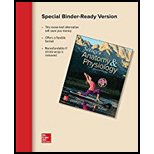
(a)
To determine:
The change in the tidal volume if vagus nerves are cut.
Introduction:
Tidal volume is the amount of air inhaled and exhaled during normal breathing. In an adult male, the tidal volume is 500ml. Tidal volume represents the efficiency of the lungs at rest.
(b)
To determine:
The change in the tidal volume if phrenic nerves are cut.
Introduction:
The organ system of the body that helps in the process of respiration is termed as the respiratory system. The respiratory system of humans is present in “air-filled” cavity called the thoracic cavity. The thoracic cavity plays a vital role in the process of inhalation and exhalation. It contains a muscular structure called the diaphragm.
(c)
To determine:
The change in the tidal volume if intercostal nerves are cut.
Introduction:
The mechanism of breathing involves contraction and relaxation of intercostal muscles. Breathing is controlled by the size of the diaphragm. The contraction and relaxation of intercostal muscles lead to a change in the size of the diaphragm.
Want to see the full answer?
Check out a sample textbook solution
Chapter 23 Solutions
SEELY'S ANATOMY+PHYS.<LSLEAF W/CONNECT>
- Women in the late nineteenth and early twentieth centuries wore whalebone corsets that severely restricted the respiratory and digestive systems. These corsets were worn to have a wasp-like waist. It was quite common for these women to faint—in fact, they had “fainting couches.” Explain the physiological reason for their fainting problems.arrow_forwardWomen in the late nineteenth and early twentieth centuries wore whalebone corsets that severely restricted the respiratory and digestive system. These corsets were worn to have a wasp-like waist. It was quite common for these women to faint- in fact, they had "fainting counches". Explain the physiological reason for their fainting problemsarrow_forwardyou are using a sphygmomanometer while listening to your patient's heart with a stethoscope. You heard the first tapping sound at 125mm Hg and then the sounds stopped at 83mm Hg. Calculate the mean arterial pressure. (A) 42 (B) 14 (C) 124 (D) 97 (E) 104arrow_forward
- (a) If a person's blood pressure is 119 mmHg over 65 mmHg, what is their mean arterial pressure, MAP? MAP = mmHg (b) What is a mean arterial pressure of 100 mmHg in Pa? P= Paarrow_forwardDecreased arterial pH (increased hydrogen ion concentration in the arterial blood) increases depth and frequency of respirations Choose from the following: (A) directly stimulating central chemoreceptors within the fourth ventricle of the medulla oblongata (B) directly stimulates the glomus cells of the aortic and carotid sinuses (C) both A and Barrow_forwardThe patient cole is sitting on a chair. Suppose he raises his arm for a blood pressure measurement, with the cuff placed 10 cm below his heart. (a) How much of an error (difference in pressure) in mmHg does this introduce in the measurement? Assume that the blood is static for simplicity. The density of blood is 1050 kg/m3. AP = (b) If the systolic & diastolic blood pressures from the patient's heart is 125 & 85 mmHg, what will the cuff's pressure reading be? & (c) Describe a way to measure cole blood pressure accurately. 3arrow_forward
- Suppose OP if rises dramatically—say because of a severe bacterial infection in the surrounding tissue. (a) Predict how fluid flow will change in this situation. (b) Now calculate the NFP at the venous end of the capillary. If OP if increases to 10 mm Hg. (c) In which direction does fluid flow at the venous end of the capillary now—in or out?* (see fig. and attached with snipped method if neccessary)arrow_forwardA person has an ejection fraction of 54% and an EDV of 130 mL. a) what is their stroke volume b) if they have a heart rate of 65 beats per minute, what is the cardiac output? c) If they increase their ED to 170 mL, what do you expect might happen to their ejection fraction (improve, stay the same or get worse)? Why- be complete in your answer. d) What law is this? e) How might the EDV be increased? Give at least one mechanism in detailarrow_forwardWhich of the following would be normal responses to hypercapnea? (select all that apply) Smaller tidal volumes Increased frequency Increased tidal ventilation Decreased pulmonary blood flowarrow_forward
- In which of the following organs would you find oxygen levels causing vasoconstriction? A) lung b) liver d) kidneyarrow_forwardAs oxygen consumption and cardiac output increase during exercise, the pulmonary diastolic pressure ________. a) increases b) decreases c) remains the samearrow_forwardDaniel, the swimmer with the fastest time on the college swim team, routinely hyperventilates before a meet, as he says "to sock some more oxygen into my lungs so I can swim longer without having to breathe." "Furthermore, my heart won't have to adjust it's output". Is he correct that his heart not having to increase output if he hyperventilates? Explain your recommendation.arrow_forward
 Human Physiology: From Cells to Systems (MindTap ...BiologyISBN:9781285866932Author:Lauralee SherwoodPublisher:Cengage LearningBasic Clinical Lab Competencies for Respiratory C...NursingISBN:9781285244662Author:WhitePublisher:Cengage
Human Physiology: From Cells to Systems (MindTap ...BiologyISBN:9781285866932Author:Lauralee SherwoodPublisher:Cengage LearningBasic Clinical Lab Competencies for Respiratory C...NursingISBN:9781285244662Author:WhitePublisher:Cengage

